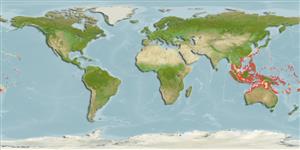>
Ovalentaria/misc (Various families in series Ovalentaria) >
Pomacentridae (Damselfishes) > Pomacentrinae
Etymology: Amphiprion: Greek, amphi = on both sides + Greek, prion, -onos = saw (Ref. 45335).
More on author: Bleeker.
Environment: milieu / climate zone / depth range / distribution range
Ecologia
marino; salmastro associati a barriera corallina; non migratori; distribuzione batimetrica 1 - 38 m (Ref. 86942). Tropical; 34°N - 22°S, 96°E - 156°E (Ref. 55269)
Western Pacific: Gulf of Thailand and Cocos-Keeling in the eastern Indian Ocean to Samoa and Tonga (Ref. 53797), north to the Ryukyu Islands, south to the Great Barrier Reef, and New Caledonia.
Length at first maturity / Size / Peso / Age
Maturity: Lm ?, range 6 - ? cm
Max length : 10.0 cm TL maschio/sesso non determinato; (Ref. 9710)
Short description
Chiavi di identificazione | Morfologia | Morfometria
Spine dorsali (totale) : 9 - 10; Raggi dorsali molli (totale) : 16 - 17; Spine anali: 2; Raggi anali molli: 12 - 13.
Adults inhabit lagoon and seaward reefs (Ref. 1602). Mainly diurnal. Non-burrowing. Monogamous (Ref. 52884). A protandrous hermaphrodite (Ref. 32166). Oviparous, distinct pairing during breeding (Ref. 205). Eggs are demersal and adhere to the substrate (Ref. 205). Males guard and aerate the eggs (Ref. 205). Associated with the anemones: Heteractis magnifica (usually), Heteractis crispa, Macrodactyla doreensis, Stichodactyla gigantea (Ref. 5911). In Bali they occur together with the closely related Indian Ocean species A. akallopison and have even been found sharing the same anemone (Ref. 48636). Has been reared in captivity (Ref. 35413, 35418, 35420).
Oviparous, distinct pairing during breeding (Ref. 205). Monogamous mating is observed as both obligate and social (Ref. 52884). Eggs are demersal and adhere to the substrate (Ref. 205). Males guard and aerate the eggs (Ref. 205). One pair spawns several times per year. Annual fecundity is estimated to be 2,000 to 4,000 eggs. Size at sex change = 5.4 cm TL (Ref. 55367). Also Ref. 240, 7471.
Allen, G.R., 1991. Damselfishes of the world. Mergus Publishers, Melle, Germany. 271 p. (Ref. 7247)
IUCN Red List Status (Ref. 130435)
Threat to humans
Harmless
Human uses
Pesca: di nessun interesse; Acquario: Commerciale
Strumenti
Warning: mysqli::__construct(): (08004/1040): Too many connections in /var/www/html/includes/speciessummary.lib.php on line 2104
Can't connect to MySQL database fbquizv2. Errorcode: Too many connections
